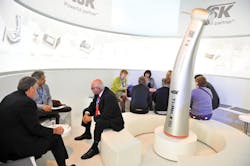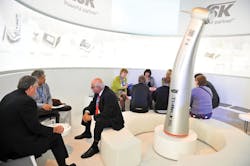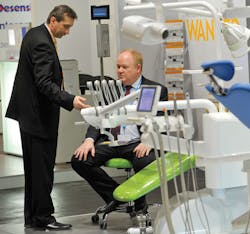Tradeshow ROI: You reap what you sow
By Mike "Mac" Caiafa and Michael Ventriello
According to recent studies, one-third of marketing executives surveyed have shifted half of their budgets from traditional to digital marketing in the past year, yet are still spending 20% of their budgets on tradeshows. This gives us many reasons to pause and think about several concerns surrounding these research outcomes.
Tradeshow marketing has always been a money pit for companies both large and small. For the most part, a surprisingly small number of exhibitors truly integrate this tactic into their overall marketing and communications strategies.
At every dental meeting we attend, we hear a good number of exhibitors grumbling about the poor results of their tradeshow participation. More often than not, they blame everyone but themselves.
Truth be told, these same exhibitors or their agencies have experienced less than stellar results because they've neglected the basics, the major one being an integrated exhibit marketing plan! (And by "marketing" we mean the discipline and not just simply a big idea or a cute promotion.)
With the shift of substantial marketing dollars to "more modern" tactics, i.e., digital outlets such as social media, we're concerned that exhibitors will run headlong into developing digital strategies to support tradeshow marketing efforts without paying attention to the basics. Because despite what some digital marketing wunderkinds say, the same proven principles of traditional marketing hold true for digital strategy and should be generously and vigorously applied.
Tried and true fundamentals
To begin, let's review the basic tactics prioritized here that make up a well-integrated exhibit marketing plan:
Understand your marketing demographics
✍ Research and target trade shows that have the optimum numbers of decision makers and influencers attending.
✍ Make tough calculated decisions on the trade shows on your annual schedule — throw those off the bus that don't attract your addressable audience in adequate numbers.
Set measurable goals and objectives for each show because fluffy goals serve no purpose
✍ Some examples of good, solid goals — attract X% of the attending decision makers and influencers to booth, detail Y% of these, sell Z% amount of product at show (if allowable on floor sales).
✍ Don't forget that existing customers who visit your booth have specific goals and objectives too.
These two fundamental information gathering and goal setting tactics need to be carefully addressed before you decide whether or not to exhibit at a particular dental meeting, and way before developing and deploying traditional or digital support tactics. Sorry, the same common sense marketing rules apply.
It's much more than pitching your tent
When you can determine that the specific meeting will attract a suitable number of attendees that fit your prospect and customer profile, you cannot just show up and hope for the best! You should follow these next steps:
Develop a plan to collect valuable data on each visitor to your booth
✍ First rule, when one of your exhibit staff engages a visitor in dialogue, collect information.
✍ Go beyond the typical data found on an attendee's "smart" badge — title, email address, direct phone number, level of interest, plans to purchase mindset, etc.
✍ Have an adequate number of card readers in your booth, which should depend on size of exhibit and anticipated number of visitors.
Card readers are one of the oldest forms of digital marketing. For decades, they have been accurately collecting valuable prospect data and exporting it into databases, or more recently, customer relationship management systems.
Despite this, many exhibitors still rely on the "card in a fishbowl" lead gathering method, and would rather spend money on booth swag (it's a really cool keychain!) or a smartphone app that no one needs (it tells you when your toothpaste has reached its expiration date!).
Establish a literature plan for each exhibit
✍ Over 20 years of research has shown that more than 80% of the sales literature distributed at trade shows never makes it home.
You know hotel maids hate when conventions are in town!
✍ Save money, be smart, and keep literature at a minimum at your booth. Better yet, design digital versions of your high-level collateral that can be downloaded and viewed via smartphone.
✍ Remember the card scanner? Based on the attendee profile, it's more useful to send literature after the show and reinforce your prospects' visits to the show.
✍ Very important: Don't just mail an over-stuffed package. Ask whether your prospect wants digital information via a web link or still prefers killing trees.
Booth pros are made, not born
Develop a comprehensive training plan for your booth staff for each show. Quite often, the weakest link in an integrated exhibit marketing plan is an ill-prepared booth staff
✍ Let them know what products and services will be exhibited, especially new offerings.
✍ Provide insight into the measurable goals and objectives (and their role in accomplishing same) for each show.
✍ Develop a profile for each show, covering types and numbers of attendees, hours, schedules, and specific responsibilities.
✍ Provide training on any new products and services and/or demos prior to each show.
✍ If your booth staff is coming in from different regions, don't conduct training 20 minutes before the exhibit floor opens. Instead, schedule a series of video conferences via WebEx, GotoMeeting, or other sites.
✍ Appoint a booth captain who has the power to oversee and ensure activities of the booth staff.
✍ Make sure staff know how to use a card reader and how to assist attendees with scanning a BRC or downloading an app if they are being used in your booth.
✍ Teach them how to use social media to report on what's happening at the booth, at special receptions, etc. This includes uploading photos and videos.
Promoting your presence
Let your target audiences know what shows your company will be attending
✍ Your website should feature a constantly-updated trade show schedule with booth numbers, dates, and locations.
✍ Add violators to your print ads and run them 30 to 60 days prior to specific shows announcing your participation.
✍ Let your field sales force know about your company's show schedule so that they can communicate such events to prospects and customers in their respective territories.
✍ If you have a call center, let your callers integrate upcoming attendance notes into their daily scripts.
✍ Send out a blanket email to members of your prospect database alerting them to specific trade shows that may be of interest to them.
✍ Send product-specific emails to prospects who have indicated interest in particular products.
✍ Send out a press release announcing any product launches, special promotions, KOL demonstrators, etc. Don't forget to include industry web portals, blogs, and social media sites in your distribution.
Time to mobilize!
The majority of dental meeting attendees use smartphone browsers to view websites. That's why you need to have a mobile-friendly version of your website live by the time you exhibit. Google offers a free tool to test the mobile compatibility of your site at http://www.howtogomo.com/en/d/test-your-site/.
The need for building an opt-in list of mobile phone numbers is where e-mail list building was 10 years ago. You can build your list by inviting attendees to send you a text message, or better yet, by scanning a quick response code (QRC), and offer them something in return for taking the time to do this, for example, a free whitepaper, webinar invitation, or product discount.
Make your booth a must-visit destination. Use a location-based service such as Foursquare to encourage meeting attendees to visit your booth. Once again, give them an incentive for checking in — a different demo every day, a different drawing every hour, etc. Make your competition wonder why you have consistent booth traffic while they're surrounded by the sound of crickets.
Influencing the influencers
When and where it is appropriate, maximize your presence at trade shows by working closely with your public relations team to take advantage of the large numbers of trade press editors that attend national shows.
✍ Hold a press conference to announce a new product or service, or to announce your company if you're using a show to launch your company.
✍ Alternatively, hold one-on-one press briefings as a more intimate vehicle for announcing news.
✍ Create a digital press kit that can be loaded on a corporate branded flash drive. Give one to every press conference or press briefing participant.
✍ If possible, take photos or short video of editors being detailed for use on social media, etc. Ask their permission.
Additionally, take advantage of the thought leaders attending trade shows, as most of them are contributing editors to dental trade magazines, have blogs, or lecture on your product category.
✍ Work closely with your professional relations team to hold one-on-one briefings or small group gatherings.
✍ Invite thought leaders to your press conference if you are holding one.
✍ Provide them with a digital press kit, and if appropriate, a product sample for evaluation.
✍ If possible, take photos or short video of thought leaders being detailed for use on social media, etc. Ask their permission.
Create a comprehensive and timely follow-up plan for each show
✍ Develop literature packages and accompanying letters (snail mail and online) to go to each visitor of your exhibit before each show. Packages should be developed for visitors who want more information, request for estimate, or a sales quote.
✍ Whether prospect requests paper or digital information, send packages out no later than four to five business days after close of show.
✍ Follow up with a phone call no later than seven to 10 days after packages have been sent.
Build it and they will come … Not
No exhibit marketing plan would be complete without discussing the actual booth structure. For many years, the "build it and they will come" syndrome was pervasive across many industry sectors. The belief was that if a company wanted to attract a large audience at a tradeshow, all it had to do was spend a lot of cash, build a large booth, and visitors would be automatically drawn to it! Wrong!
Let's go back the beginning
If you're one of the fortunate ones and are about to move ahead and build a new exhibit property, remember some of the basics:
✍ Review the measurable goals and objectives for your tradeshow program, and make sure that when you begin discussions with your exhibit builder that your overall goals are considered.
✍ Make sure that you're not building a one-size only exhibit. Take into consideration your show schedule, and build in a lot of flexibility. For example, think about having an exhibit design that is modular and allows you to exhibit in a 30' x 30' island configuration, but also in a 20' inline configuration.
Think about those life cycle costs, and remember that exhibiting is an expensive undertaking.
✍ Consider lightweight materials to cut down on shipping, storage, and drayage costs.
✍ Consider simple but eye-catching designs that don't take a work crew of eight two to three days to install and dismantle.
Back to your goals and objectives
✍ When developing a design, think about how your booth staff will be deployed and how your team will carry out its mission.
✍ When developing a design, think about eliminating physical and mental barriers that might stop visitors from stepping into your exhibit space.
Graphics and signage should not be an afterthought, or the star of your show
✍ There needs to be a balance between easy reading and easy consumption of your messages the watchwords,
✍ Consider the use of digital signage. LED technology has come so far that it's used on roadside billboards. Good design and graphics transitions can really make your booth stand out.
✍ Take control of your airspace. A well-designed banner suspended from the rafters is still probably the best way to help dental meeting attendees find your booth. Whether or not you can do this will depend on your booth configuration and exhibitor rules. Continued on page 24
✍ When well produced, large screen video presentationsand videos can be very effective in pulling people into your booth. Make sure the video is compelling even without audio, as you may be restricted regarding how loud you can crank the volume.
Now, what happens when you're stuck with a legacy booth, one that is clunky, gaudy, and hardly meets your overall goals and objectives? Take little bites at a time. Decide what needs to be fixed first, with the least amount of effort and budget, then move forward.
A graphic panel here, a video screen there, fresh carpeting and some strategically placed QRCs with useful incentives here, and you'll be surprised at how much additional mileage you can get from "Ol' Bertha," the 1999 exhibit queen.
Ask a hired gun – Consider hiring an industry thought leader to lecture on a topic related to your product. This will require the payment of an honorarium.
✍ You will need adequate A/V and seating.
✍ Promote the thought leader's appearances via all pre-event marketing materials, social media, etc.
✍ Don't forget a sign in your booth announcing the times of the appearances.
✍ Document the appearance with photos and videos to use on your website, social media, and follow-up marketing. Be sure to ask for permission.
We are fortunate to work with several global exhibit designers and builders who are more than just "hammer, nails, and paint" organizations. They truly understand their role and the role of the exhibit structures they design, build, and retrofit in the integrated exhibit marketing scheme. When you partner with a reputable exhibit firm, you should expect no less!
Parting advice
As you can see, once the basics of tradeshow marketing are covered, there is no reason not to integrate digital strategies as part of your overall plan. There are several caveats, though.
✍ If you depend on in-house talent to develop and deploy digital marketing strategies, make sure that their efforts are part of an integrated plan.
✍ Ensure that all brand positioning and graphic elements are carried over to the digital world.
✍ If you use an outside agency or contractor, check to make sure there are no pretenders. Do your homework to make sure that their digital marketing experience is genuine and not simply another notch on their capabilities' belt. Get references and case studies.
See you on the exhibit floor!
Now that you've embraced the basics of traditional tradeshow marketing, which will drive your digital support tactics, it's time to hit the exhibit floor and make some sales!
Mike "Mac" Caiafa has been practicing his strategic marketing and marketing communication craft for over 30 years. In the area of exhibit marketing he has developed and executed scores of successful integrated programs for companies in the pharma, medical device, and dental sectors. He can be reached at [email protected].
Michael Ventriello is a strategic marketing consultant with 25 years of integrated marketing, advertising, and public relations experience in a variety of fields, including high-tech, consumer packaged goods, and health care. He can be contacted at [email protected].




